26-6-2000 (day 10)
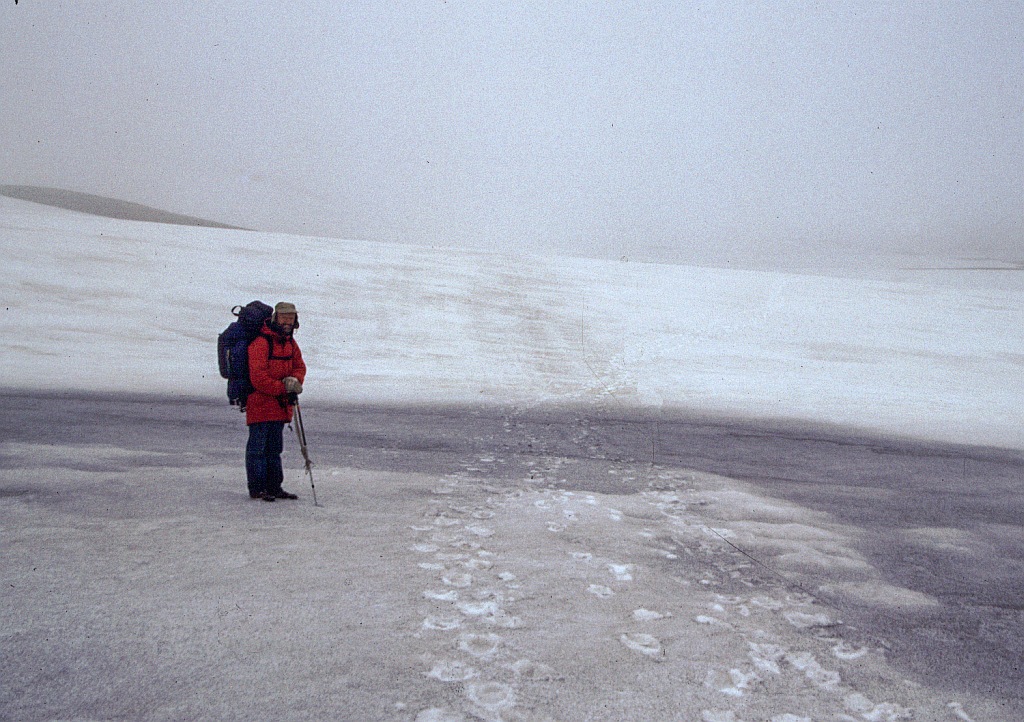 In the morning it was the reverse, pull down the camp have breakfast and go. About a kilometre from the hut we came across two guys, busy pulling down their tent; they were two Germans on the same route as us. Today we had a major step, from 600 to l000m, all in one steep uphill. The Germans overtook us here and it was getting unpleasantly cold and windy. Once over the top we had a coffee rest and not far from there we saw the first fumerol, that is a hot spring. It wasn't much of a spring; more steam than water, and not only steam also a fair amount of H2S (hydrogen sulfide). So much so that we were concerned about getting poisoned by the substance and kept mostly upwind from it. It was fascinating to see all that stuff come out of the ground.
In the morning it was the reverse, pull down the camp have breakfast and go. About a kilometre from the hut we came across two guys, busy pulling down their tent; they were two Germans on the same route as us. Today we had a major step, from 600 to l000m, all in one steep uphill. The Germans overtook us here and it was getting unpleasantly cold and windy. Once over the top we had a coffee rest and not far from there we saw the first fumerol, that is a hot spring. It wasn't much of a spring; more steam than water, and not only steam also a fair amount of H2S (hydrogen sulfide). So much so that we were concerned about getting poisoned by the substance and kept mostly upwind from it. It was fascinating to see all that stuff come out of the ground.
 The route wound itself around a number of those fumerols and went further up. And the snowfields started again, kilometre after kilometre of sloshing through the stuff. Up here we met this team of four British hikers. Inquiring about the next hut and our desire to camp nearby was answered by 'if you like to camp on 4 metres of snow'. This made us decide to rather use the hut for sleeping in this time. Not only was the walking becoming difficult because of the snow, now we also had wind and mist. There was nothing else to be done but to slog on and eventually out of the mist came the silhouette of the hut. Just before that we walked through a field of beautiful and large pieces of Obsidian. This is that shiny glass like lava; it would be great to have a rock garden made from it. But how do we get the truck up here to load it?
The route wound itself around a number of those fumerols and went further up. And the snowfields started again, kilometre after kilometre of sloshing through the stuff. Up here we met this team of four British hikers. Inquiring about the next hut and our desire to camp nearby was answered by 'if you like to camp on 4 metres of snow'. This made us decide to rather use the hut for sleeping in this time. Not only was the walking becoming difficult because of the snow, now we also had wind and mist. There was nothing else to be done but to slog on and eventually out of the mist came the silhouette of the hut. Just before that we walked through a field of beautiful and large pieces of Obsidian. This is that shiny glass like lava; it would be great to have a rock garden made from it. But how do we get the truck up here to load it?
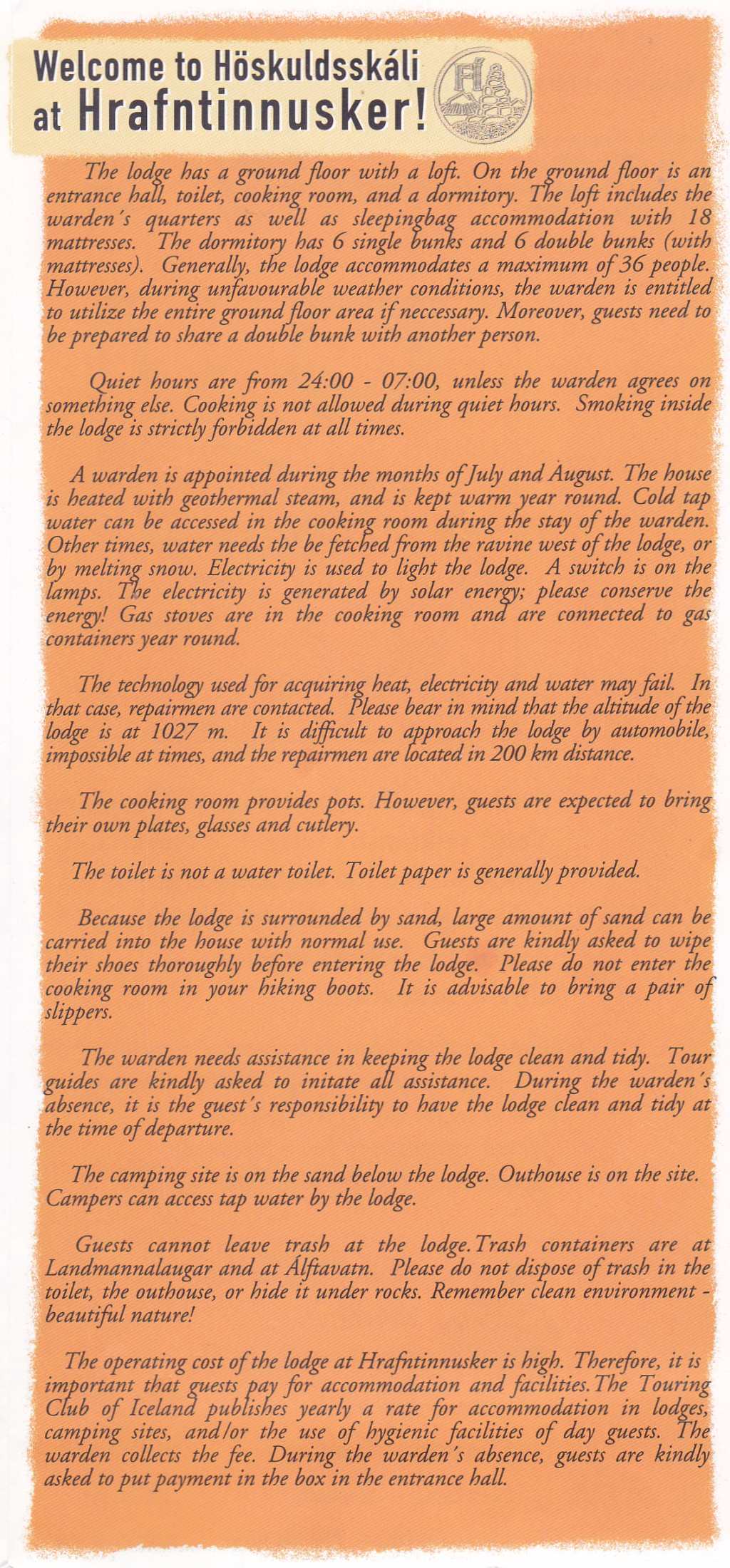 The Germans were there already, but didn't want to stay; their aim was to make it to Landmannalaugar. The hut was absolute luxury, it is geothermically heated, all on an automatic system. Best is let me copy the whole story from the brochure. We had the hut all to ourselves, cost 1200 Krona each. We were supposed to put the money into the box but didn't have the right change and decided to pay at the hostel in Landmannalaugar.
The Germans were there already, but didn't want to stay; their aim was to make it to Landmannalaugar. The hut was absolute luxury, it is geothermically heated, all on an automatic system. Best is let me copy the whole story from the brochure. We had the hut all to ourselves, cost 1200 Krona each. We were supposed to put the money into the box but didn't have the right change and decided to pay at the hostel in Landmannalaugar.
26 June
Packed up at 7.45am and breakfasted on porridge and coffee in the hut, then headed north, passing two north-bound Germans camped by the stream. Up and up to snow patches. then a series of hot springs, mostly fumaroles. Met 3 Poms and an Edinburgher coming south - they had got to Landmannalaugar by mountain-taxi - on the long, cold and wearing snow trudge to the Hrafntinnusker Jökullhaus at 3.30pm. This unmanned hut among nice basalt rocks and snow banks had piped geothermal heating, really hot in the drying vestibule and cosy throughout. Into T -shirt and shorts to read Emma. sort out rock samples. tidy up rucksacks and eat soup, savoury mince and herbal Smash with Bowmore and water Then wash clothes and bodies and even shave. What a pleasant place.
We're in Friðland ad Fjallabaki reserve. North-ward towards Landmannalaugar are three rhyolite mountains - Blahnukur, Brennisteinsalda and Kirkjufell. North and south of the road west via Landmannahellir are two tuff mountains called Loðmundur and Mogilshöfði. Rhyolite lava usually makes grey, yellow, pink or green rock (like some of todays mountains), but fast-cools to obsidian. The reserve only has a two-month growing season and is infertile, with 150 flowering plants and ferns, dwarf willow in dry gravelly areas and lava fields, and common cotton grass in wet areas. Marsh cinquefoil and common sedge grow in the geothermal areas, and racomitrium heath (moss) covers much of the tuff mountains. The cold lakes host small animals and trout. Snow buntings are the commonest birds - Solskrikjur in summer: Snoeugla when white in winter And, on the lakes, himbrimar (common loon), alftir (swans) and oðinshanar (northern phalaropes). Reading, rice pudding and marmalade at 10pm.
27-6-2000 (day 11)
We had the hut to ourselves for the night; nobody would be that daft to come up in this sort of weather. And the weather was shit. It had started to snow over night, the wind was blowing strong and visibility was low. Certainly not a pleasure to be on a hike. In addition we had the worry that the fresh snow had wiped out the tracks of the Germans. So we stuck around hoping for an improvement in the conditions. At one time I went outside to 'feel' the weather and came back very disappointed, I couldn't walk around the hut because the snow was being blasted into my face as I came out of the cover of the hut and into the wind.
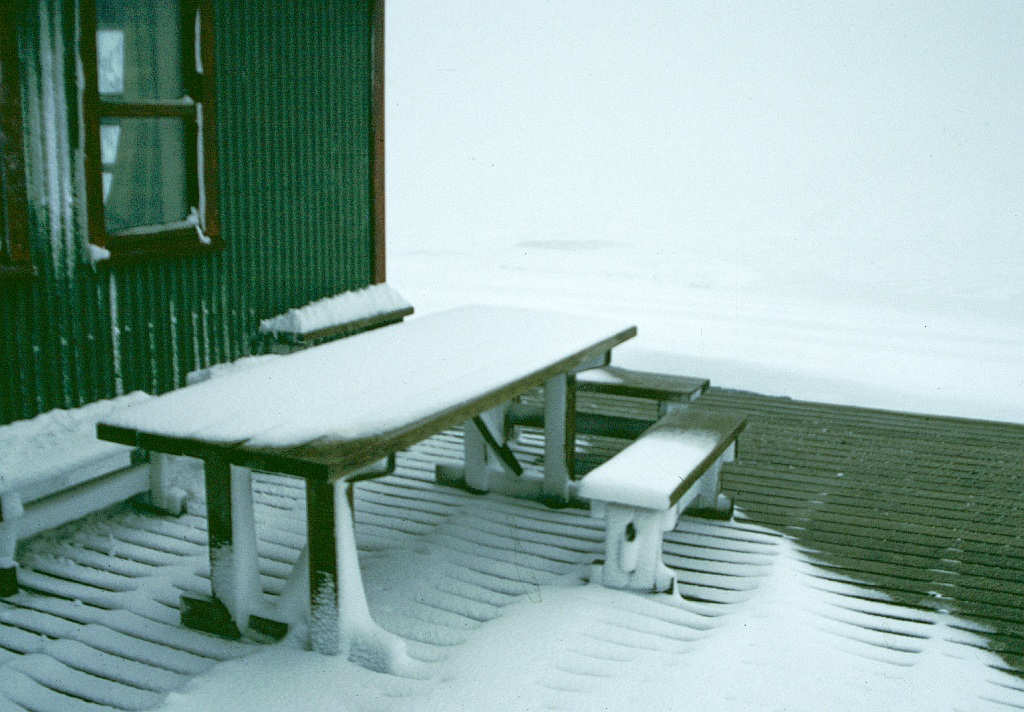 We used the time to further explore the hut. The toilet was of interest. It had this long lever that one had to move over before it became possible to open the lid. The secret of that was a slide valve that opened as the lever was operated to keep the smell out of the hut. Very clever! And I don't know how they did it but the toilet had a warm seat. Looking down into the depth of the chute we noticed a red glow and developed theories about some incinerator that immediately destroys all the waste and thus no smells. On closer inspection, no Jim didn't stick his head in, it turned out to be the downpipe passing between the building, which is elevated on supports, and into
We used the time to further explore the hut. The toilet was of interest. It had this long lever that one had to move over before it became possible to open the lid. The secret of that was a slide valve that opened as the lever was operated to keep the smell out of the hut. Very clever! And I don't know how they did it but the toilet had a warm seat. Looking down into the depth of the chute we noticed a red glow and developed theories about some incinerator that immediately destroys all the waste and thus no smells. On closer inspection, no Jim didn't stick his head in, it turned out to be the downpipe passing between the building, which is elevated on supports, and into  the ground. The pipe is made of some reddish half transparent plastic and the light is actually daylight.
the ground. The pipe is made of some reddish half transparent plastic and the light is actually daylight.
Eventually we had to make a move; somehow we didn't feel like staying another night here. If the weather continuous then all footprints will definitely have been wiped out. The visibility had improved somewhat, but the wind and snow was still as strong as earlier. At least we would have the Wind from behind. We put on everything we had; I had lots of layers under my rain jacket. Dressed like mummies we stepped out to be picked up by the wind and driven up the mountain. That was the way we had to go anyway. There were kilometres of snowfields again. Marking sticks were not seen that often and we mainly followed the footsteps of the Germans. They were not always visible due to the new snow and at one stage we had lost them and had to search till I noticed a stick in the mist. Going for that we found the foot prints again.
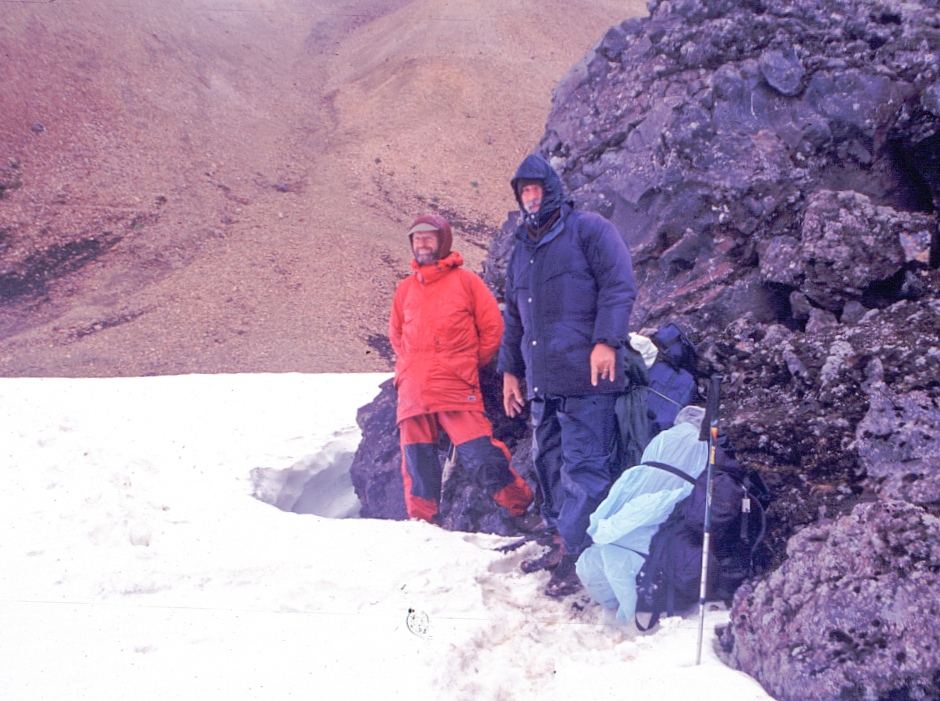 Our route took us mostly downhill to the fumerols; one of them had a pool with warm water inviting to sit in it. The Britishers had done that, but the thought of taking off our clothes was not very inviting. So we pushed on. In fact we pushed and pushed over snowfields, over soggy snow free patches without stopping until we were really going down and had Landmannalaugar in sight. Here we had a place to get out of the wind and could sit down. We had been walking non-sit-down for 3 1/2 hours. This was the first time I actually pulled out the camera to take a group photo.
Our route took us mostly downhill to the fumerols; one of them had a pool with warm water inviting to sit in it. The Britishers had done that, but the thought of taking off our clothes was not very inviting. So we pushed on. In fact we pushed and pushed over snowfields, over soggy snow free patches without stopping until we were really going down and had Landmannalaugar in sight. Here we had a place to get out of the wind and could sit down. We had been walking non-sit-down for 3 1/2 hours. This was the first time I actually pulled out the camera to take a group photo.
Another 1/2 hours and we were in Landmannalaugar. Jim didn't offer much resistance when I suggested staying in the hostel for 1200 Krona each per night. The camping ground didn't look inviting at all; it was a wet day. I used my credit card to pay since I thought that this would look very nice on my credit card statement. At the same time I wanted to pay for our stay in the Hrafntinnusker hut, but was informed that if there is no warden then you don't pay. How could I argue with that? One of my disappointments was to find that there is no shop and I was out of supplies. I had been so certain that there would be a shop that I had just brought enough to get me to Landmannalaugar. Jim let me have some of his soya mince and smash. But as we came to the kitchen to make dinner we were told to come and eat hamburgers, boiled potatoes and peas. This was because there being a construction team who had this lady cooking for them. She had cooked too much and we were offered a free meal. What luck, I didn't have to touch the Soya stuff. Before l started the meal I felt like saying a 'thank you lord prayer' but had to remind myself that it was the cooking lady who had provided the food.
And Jim realised that he had left his pot grip behind in Hrafntinnusker, this made him very unhappy. Offering that he could use mine did not help.
27June
Nice warm sleep until 7.30am, then tea, porridge, bread & cheese and more reading before dressing up in everything for two more soups then an 11.45pm start into driving wind and snow. Brr! WHAT A HIKE! I had my hat, down hood and red-suit hoods tight down over my right cheek and the other eye squinting at the ground. Gloves and double socks were soon soaked. The trudging was very tiring, there were few yellow plastic poles marking the route, and new snow obscured much of previous hikers tracks. It is true that I suggested turning back but Horst was for pressing on. We passed some fumaroles and hot pools, but it was Nice warm sleep until 7.30am, then tea, porridge, bread & cheese and more reading before dressing up in everything for two more soups then an 11.45pm start into driving wind and snow.
Brr! WHAT A HIKE! I had my hat, down hood and red-suit hoods tight down over my right cheek and the other eye squinting at the ground. Gloves and double socks were soon soaked. The trudging was very tiring, there were few yellow plastic poles marking the route, and new snow obscured too cold even to detour to view them. 3-4 hours later we reached a large lava field and followed it down past more fumaroles to the Landmannalaugur hostel, where Horst paid us both in for the night. Cocoa and tea and warmth gradually dried us out and civilised us again as we chatted with the wardens help-girl (26, au-paired for six months in Jersey, also visited Greenland's Narsaq/Qaqortoq) and Ausgerda the Icelandic-only corka (cook, for hostel-extension builders). Walked out briefly in wet socks and boots to see the hot water outlet and bathing pool, and rushed back inside to get warm again, eat and read. Ausgerda gave us left over meat (horse?) patties, boiled spuds and mushy peas, which we wolfed gladly after our soup.
Horst was nearly out of food, having expected a shop. I had left my pan-clip behind again, at the last hut, dammit. It was meant to be lost, said Horst - I should have taken the first time as a warning and just left it lying somewhere. I did!
28-6-2000 (day 12)
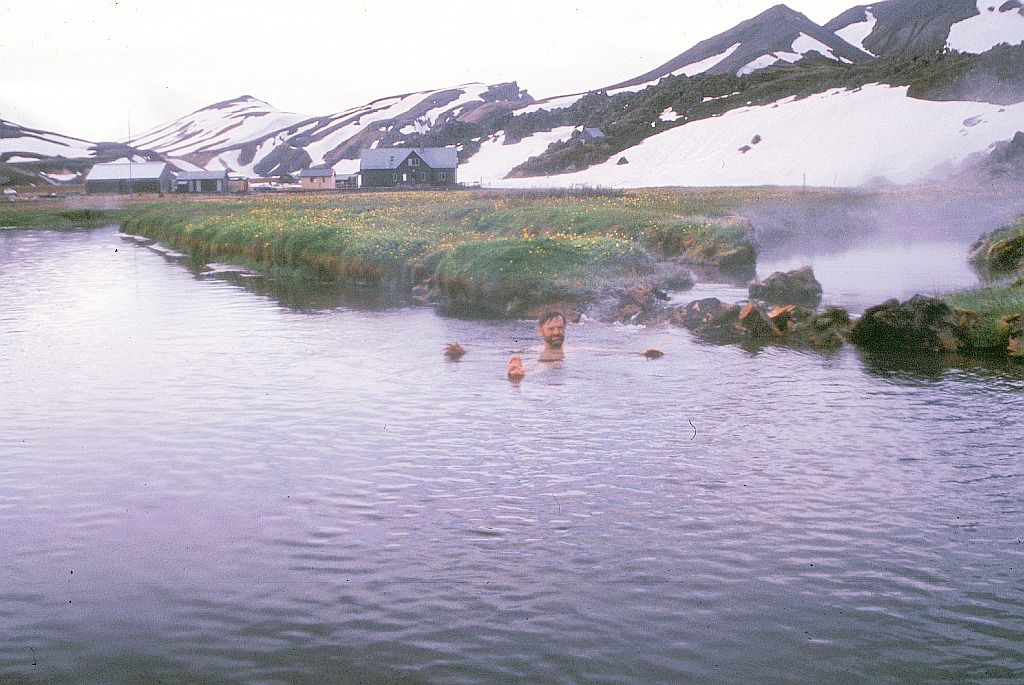
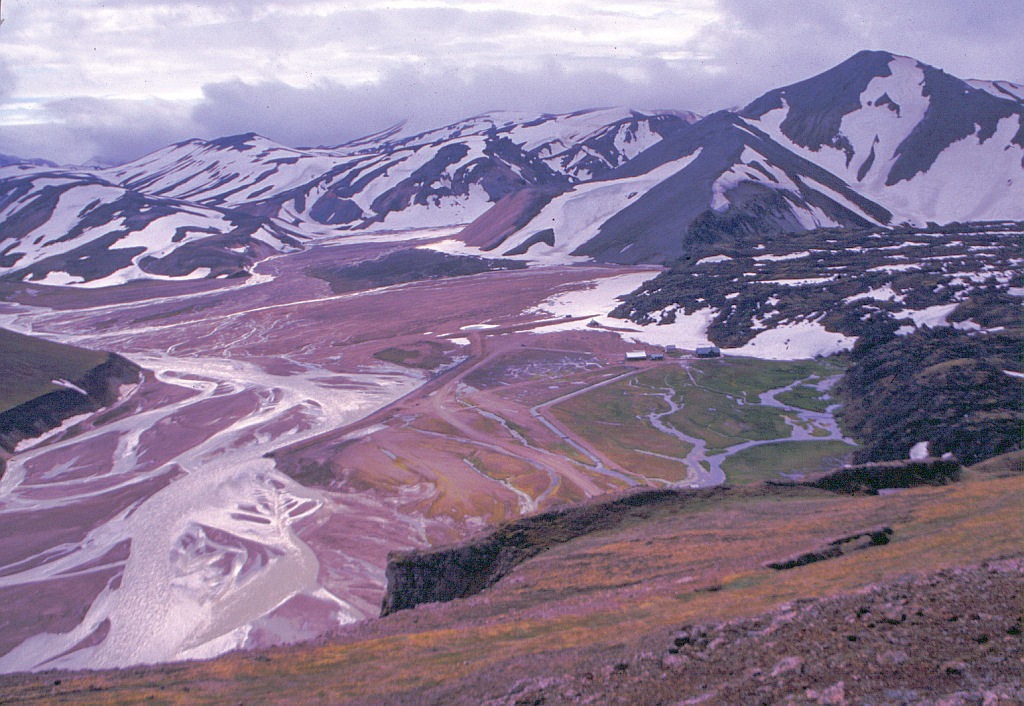 Now we had a problem, the first scheduled bus is only expected on the l-July. What do we do until then? We postponed this decision making until later and had a comfortable sleep; the weather was fine, overcast with sunny spots and no wind. This was the time to get into the hot pool. It’s fed from a natural spring and we stayed in it for about 2 hours.
Now we had a problem, the first scheduled bus is only expected on the l-July. What do we do until then? We postponed this decision making until later and had a comfortable sleep; the weather was fine, overcast with sunny spots and no wind. This was the time to get into the hot pool. It’s fed from a natural spring and we stayed in it for about 2 hours.
A hike up the mountain was next on the agenda. Whilst doing that we noticed a bus coming in which was still there when we came down and decided to chance it. The driver was prepared to take us, but he was not going back to civilisation but rather on some torturous route and to a stop overnight in some mountain resort. That didn't suit us.
It was lunch time and the cooking lady had cooked too much food again, so we could help ourselves to haddock and boiled potatoes, plus some mutton fat that one eats with the boiled potatoes, very tasty. A walk over the lave field behind the hostel and another 2 hours in the pool rounded off the day. Well not totally, the horses arrived. That was a group of riders on Iceland ponies. They had Jim's immediate attention. It was a group of people from all comers of the globe on a riding tour in Iceland.
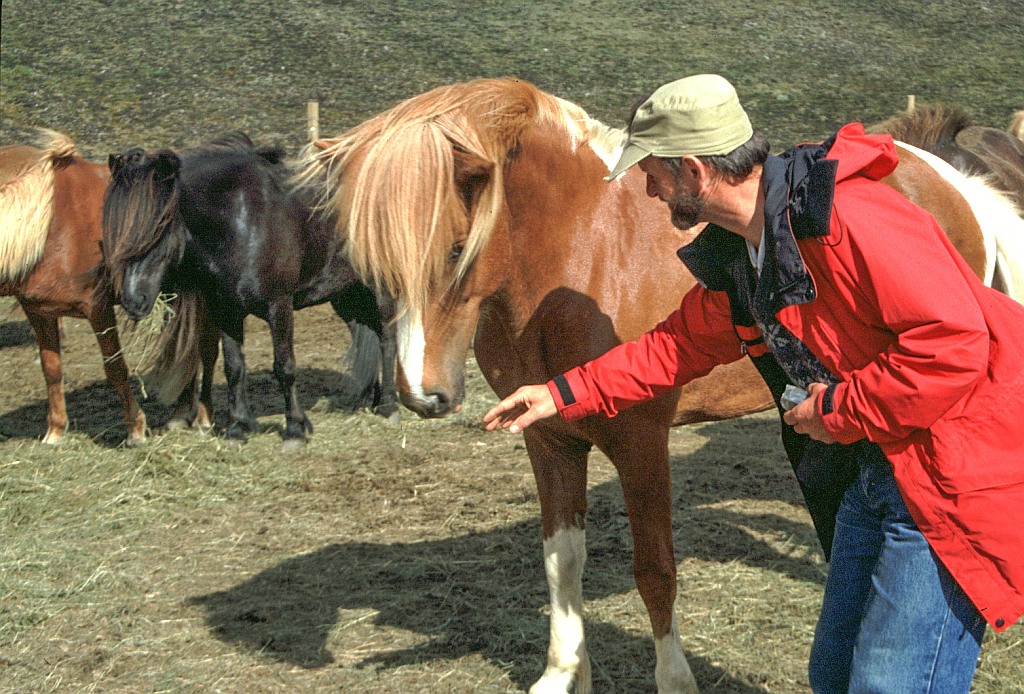 28 June
28 June
porridge, lemon tea and honey reading. Half Iceland's population believes in hidden huldufolk, Eves un-washed children), and yes, our help-girl studied folklore and believes in the old or little elf-like people. She was unimpressed with The Prince Valiant cartoon/Pliny suggestion that they were Neanderthals shipped out by the Romans.
In a fairly windless calm we enjoyed two hours in the lauga (hot pool) while I tried unsuccessfully to persuade Horst about driver-seatbelts. After cocoa, we walked up the hill to the west for photos of the area and our onward route. Horst chatted with a tourist-bus driver but decided we would not take a lift west-wards. Ausgerda offered us leftover boiled salt had-dock with Icelandic spuds, lamb fat, and orange juice for lunch, so we stuffed ourselves. Then in tölted 20 Iceland ponies bearing lady riders, mostly American, so I went for a chat and to snap the ponies being housed and fed their hay. Then another 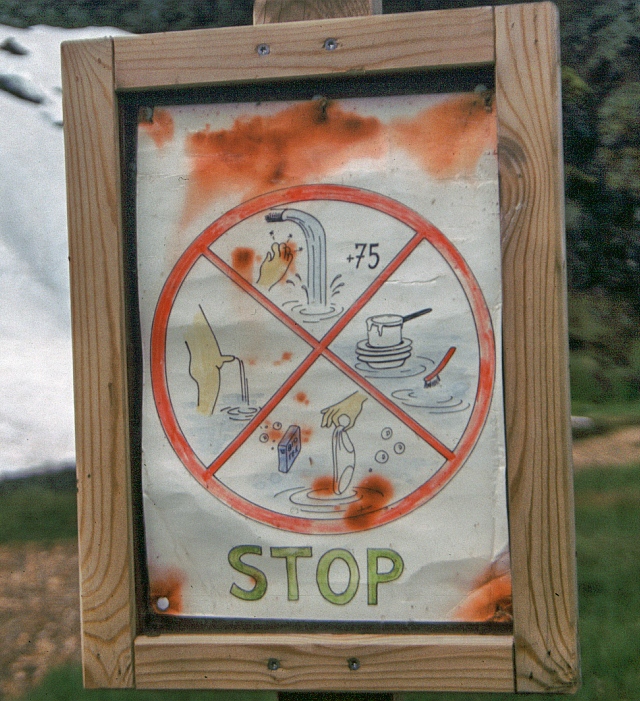 two hours in the pool, whose gravel bottom bubbles and is hot if you dig down.
two hours in the pool, whose gravel bottom bubbles and is hot if you dig down.
And, while evening reading, the warden called us down for yet another free meal, of meat patties, potatoes and pickled red cabbage. Aaah, lovely grub, with water then a walk to the river before bed. Funny 'do not' sign at the hot spring.
29-6-2000 (day 13)
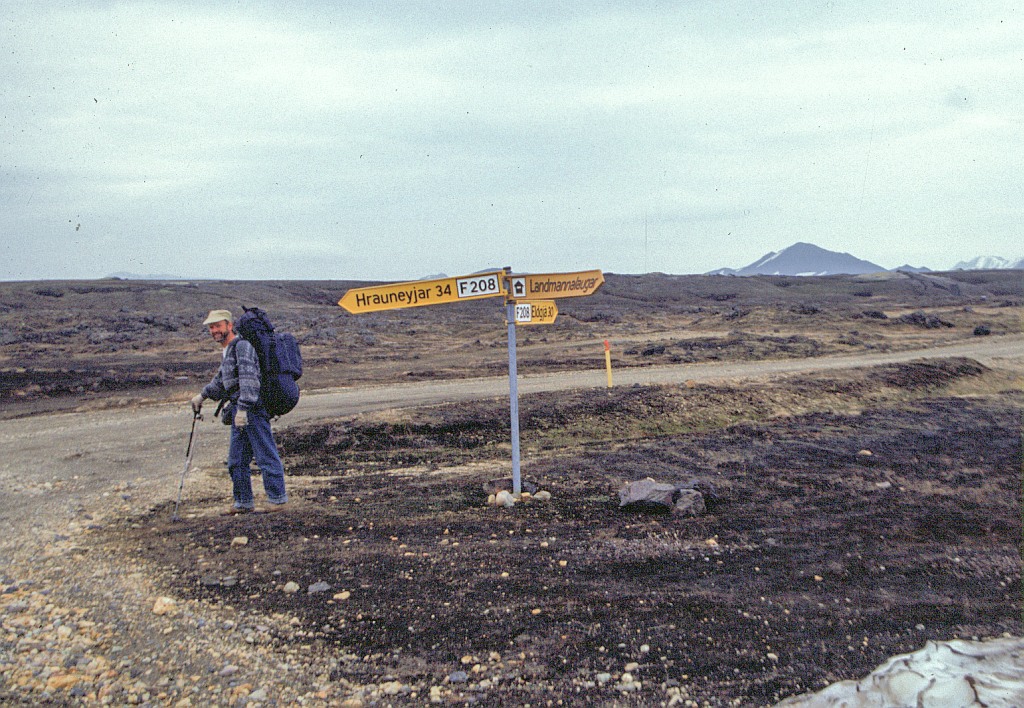 The best would be to walk the route that the bus would be coming, rather than sit around. It is an easy hike to Landmannahellier. Those were Jim's words and so we went. The horse people were also riding that way; we would meet up with them. The walk was close to 20 km, which we did in about 5 hours with only a coffee break in between. We were following the road and as we walked along it we could see that there would be no bus on the l-July. At places it was still covered in snowdrifts. Not even a 4X4 bus would be able to get through that. Jim maintained that in that case we would just carry on walking until we get to the main road about 50 km further on.
The best would be to walk the route that the bus would be coming, rather than sit around. It is an easy hike to Landmannahellier. Those were Jim's words and so we went. The horse people were also riding that way; we would meet up with them. The walk was close to 20 km, which we did in about 5 hours with only a coffee break in between. We were following the road and as we walked along it we could see that there would be no bus on the l-July. At places it was still covered in snowdrifts. Not even a 4X4 bus would be able to get through that. Jim maintained that in that case we would just carry on walking until we get to the main road about 50 km further on.
Once at Landmannahellier, which consists of a few huts and a stable, we inquired at the hut with the 'I' sign and were told that they would not expect any bus for some time. I obviously had a problem; not Jim, he was going to carry on walking. But, she said, if you go around the corner there is a construction crew building a house, one of them is going out tonight. So we went and asked, yes no problem he is driving out after work to go home to Laughaland which is near the N1. Great, we have been saved. He will be leaving at around l8h00. We killed time by walking around the mountain for a bit. Interesting was a deep gorge, obviously cut by water, resulting in an extensive rubble plain. The rubble being volcanic ash of which the whole mountain was made of.
In the meantime the horse people arrived, which again was a bit of excitement for Jim. We waited for our lift, from l8h00 it became l.9h00 and the horse 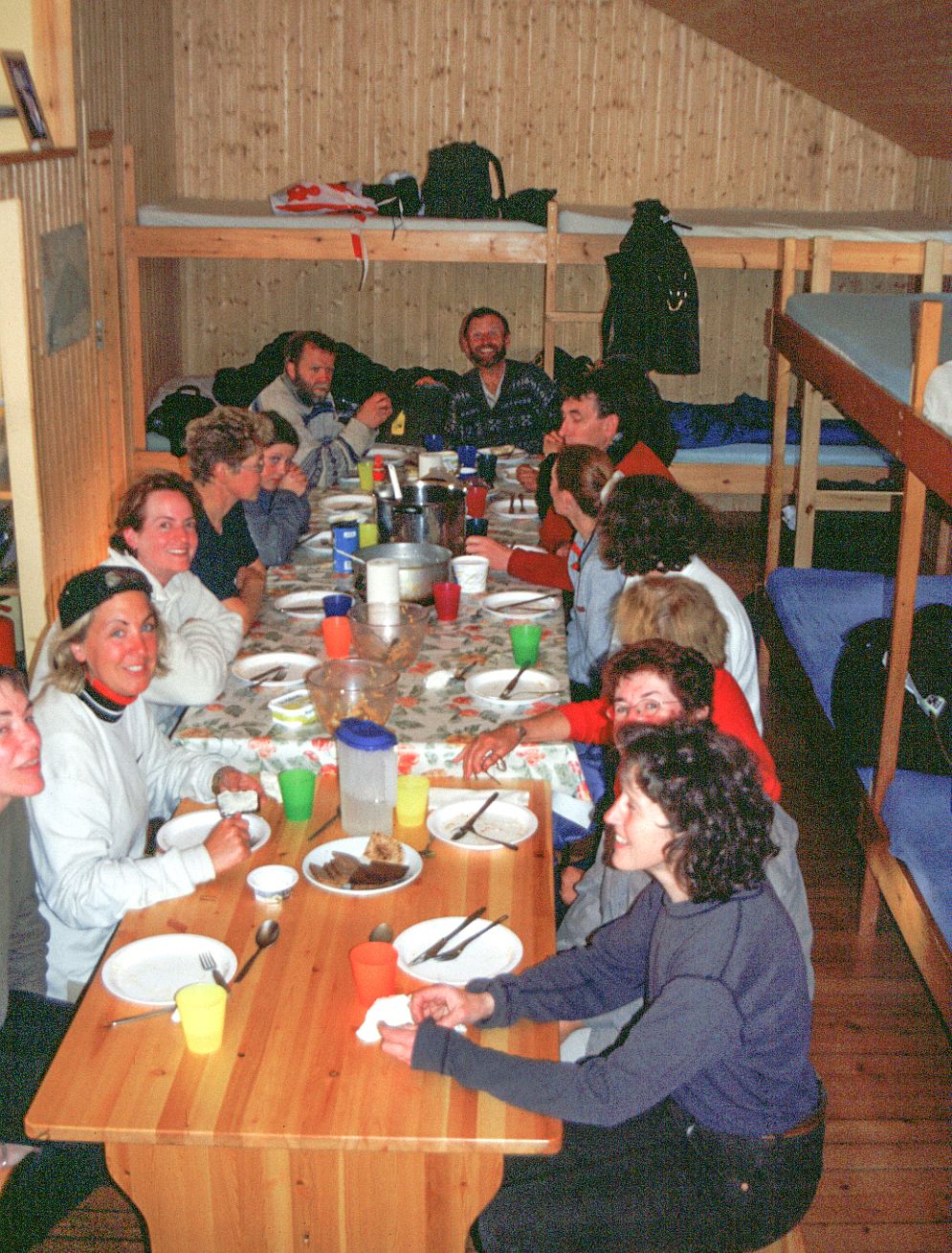 people invited us for dimer. We gladly accepted when we were told that the construction crew was still working. It was a lovely dinner of meatballs, rice and salad. It is now 21h30 and we are still waiting. They most likely decided that because the weather is so nice, sun is still shining that they would carry on. Finally at 23h00 we were told to jump in and lets go.
people invited us for dimer. We gladly accepted when we were told that the construction crew was still working. It was a lovely dinner of meatballs, rice and salad. It is now 21h30 and we are still waiting. They most likely decided that because the weather is so nice, sun is still shining that they would carry on. Finally at 23h00 we were told to jump in and lets go.
And what an interesting drive it was. First obstacle was the flooded river, Svalaskars. No problem, put the Suzuki into 4-wheel drive and through we go. The crossing was wide and fairly deep; trying to cross this on foot would have been a problem. The track wound itself through lave field after lave field, all from Hekla. The spookiest was the area that had suffered from the most recent eruption in February this year. A layer of black volcanic ash covered everything. This went on for kilometre after kilometre; it's a total desert. Just a pity I couldn't take any pictures. One of the problems with the road is that the ash fell onto snow that as a result has not melted yet. One can drive over lava and suddenly drop in because of the soft snow underneath. The road is actually closed, but our driver had a special permit to allow him to get to the building site. He, by the way, was the owner of the new house and in his normal job was the manager of a string of Health Clubs in southern Iceland.
Coming closer to the National road he showed us some of the damage done by the recent earthquake, cracks in the road. He also wanted to show us a large crack that apparently had opened up on some farm but he couldn't find it. Fortunately, because we were getting very tired, it was now well past midnight. By 01hl5 we got to Laughaland, a place only 4 km off the N1. We put up our tent in double quick time and by 0lh30 were falling asleep.
29. June
8:30am packing after breakfast to hike west to Landmannahellir, hoping for a lift sometime. It was a long track to trudge. downriver; around a lake, and over endless black plains, neither windy nor cool, but with brief drizzle. Horst lunched in a lava field, spilling his coffee water, while I munched a Bar-One and wondered what Links Colinsdottir was doing right now- 9. 30am there - tea with Linda, perhaps, and the children hard at work at school?
After 20km and occasional snow-patches it was 3:30pm at Landmannahellir; and the riding ladies arrived a bit later Horst asked around and found a carpenter willing to drive us out of the mountains that evening, as he went home. So we walked around while we waited, and helped a bit with the horses, and chatted with French, Swiss. Ohio and Californian ladies, all very pleasant. Their host invited us to join their supper of lamb meat balls, rice and salad, orange juice, cheese and flatkokur (like pita, from oats), then fruit yoghurt, red berry sauce, plain yoghurt and cream, and an enormous apple. Still, we got chilly waiting until the builders finished at 11pm and our driver took us off west through Hekla s ash fields.
A black pumice cover from the February eruption had kept the winter snow from melting, and the mountain road was closed. but he had a permit for his 4x4. We passed an extensive 5m deposit t of white (long and well-cooked before a delayed eruption) pumice from the 1801 eruption. which is quarried and shipped to Germany as building material (and also used for stone-wash tumbling denim cloth).
A rich philanthropist has a project to grass the ash field. Farms are large, with ancient mountain-grazing rights but many absentee (Reykjavik) landowners who don't take up their summer grazing (2000 sheep per area) because of the costs of trucking sheep in and out. Our driver joins the August round ups by horseback and trucks, and is ambiguous (like the horse-manageress) about development, hot water; showers etc. in wilderness areas, preferring trekkers to tar roads, hotels and tour buses.
In the lowlands, Hekla s lava had swept away most of the 3m topsoil, leaving only a few raised grass-islands in desert. We saw cracks in the tar road from the 20 June earthquake, but couldn't (at chilly midnight) find the new fissure by a farm road. Our enthusiastic driver dropped in briefly on his daughter and ex-wife, then left us at Laugaland pool resort (closed by the earthquake) to camp.
30-6-2000 (day 14)
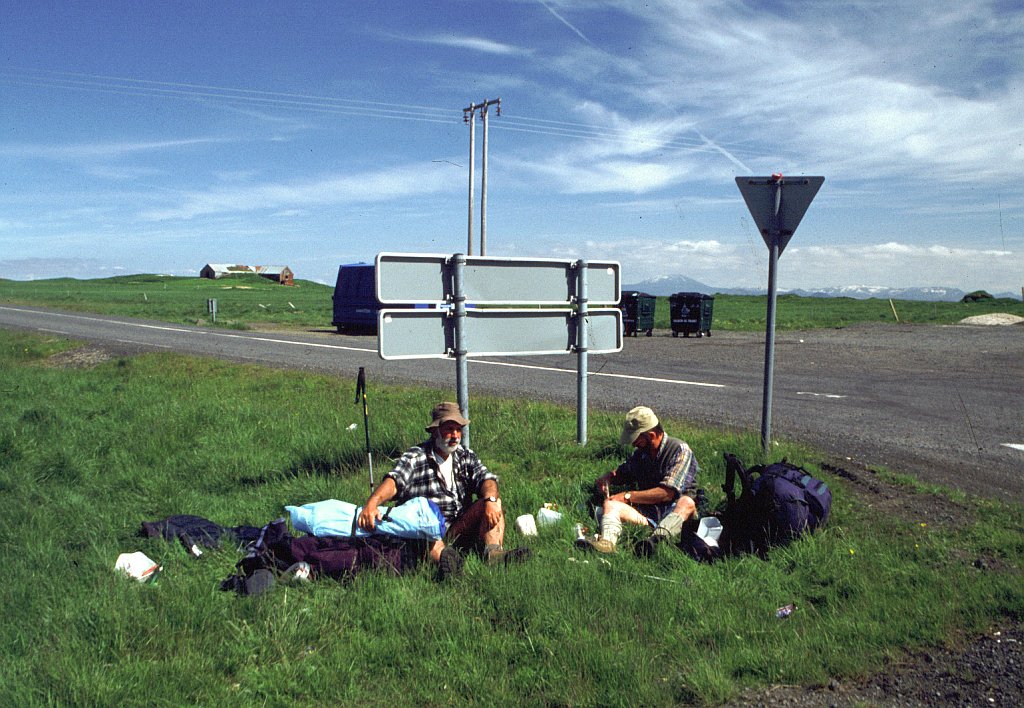 We woke up to glorious sunshine and are now sitting here in shorts and T-shirt. The sun was used to wash and dry a few things. Laugaland is a hotel with hot pools, water slides, saunas etc. And they also cater for campers. We had a look around when we went to pay. The hotel was actually closed because they received so much damage during the earthquake that they had to get the construction crews in to fix it up again. The main damage was to the swimming pool, which they had to drain to fix up the cracks.
We woke up to glorious sunshine and are now sitting here in shorts and T-shirt. The sun was used to wash and dry a few things. Laugaland is a hotel with hot pools, water slides, saunas etc. And they also cater for campers. We had a look around when we went to pay. The hotel was actually closed because they received so much damage during the earthquake that they had to get the construction crews in to fix it up again. The main damage was to the swimming pool, which they had to drain to fix up the cracks.
And than we went down the road for about 4 kilometre to meet the bus on the N1. At the junction are a petrol station and a small shop. This was used to get new supplies. I was nearly totally out of food and would have to make use of Jim's Soya mince and smash if it had not been for the free meals we have had. There were about 2 hours to kill which was used for a sumptuous lunch using the fresh bread, the Caviar paste and the Icelandic white mildew cheese (a type of camembert of exquisite taste) and herring in a pickle. All that was done sitting in the lovely green grass next to the road. It gave me an opportunity to observe the traffic (how exciting). I took note of the fact that nobody was speeding. The general speed limit on tar roads is 90 km/hr and my observation was that every car came past at the same speed, i.e. 90. Not a single car was going faster. Now, why would that be? I think it may be because of the small gene pool and all Icelanders are very similar in psychological make-up.
 Eventually the bus arrived, got on and off at Selfoss. The camping site is close to the town centre and we immediately moved in. An hour or two was spent walking through town, Jim exchanged some money and I had fun drawing a few thousand Krona from the machine. It worked without a problem.
I resisted the temptation to buy more things in the supermarket. But Jim could not resist the temptation to buy a new pot grip; it only cost him the equivalent of R37 . In one of the shops were hiking sticks exactly like ours, but there they sold them for 3000 Krona or R300. Outdoor Warehouse is selling them now at R165. How does that work? Do the French, that is where these sticks come from, sell them to different countries at different prices or do the Icelanders put on such a heavy mark up?
Eventually the bus arrived, got on and off at Selfoss. The camping site is close to the town centre and we immediately moved in. An hour or two was spent walking through town, Jim exchanged some money and I had fun drawing a few thousand Krona from the machine. It worked without a problem.
I resisted the temptation to buy more things in the supermarket. But Jim could not resist the temptation to buy a new pot grip; it only cost him the equivalent of R37 . In one of the shops were hiking sticks exactly like ours, but there they sold them for 3000 Krona or R300. Outdoor Warehouse is selling them now at R165. How does that work? Do the French, that is where these sticks come from, sell them to different countries at different prices or do the Icelanders put on such a heavy mark up?
After dinner Jim wanted to have a beer and I was misled to also want one. 450 Krona each, we must be soft in our head. At this camp-site the hot showers were free, copious use was made of that and we declared this to be the best camp-site in Iceland.
30 June
Sunshine at 8am, as we washed everything in nice hot water and changed clothes. The educational resort had interesting paintings and displays, and free coffee. We hiked along the tar road, past birds and horses, to buy groceries, lunch and loaf by the N1 until the 3.30pm bus came by. Then we camped in Sellafoss and explored town, shops and library in a still-sunny evening.
I found an expensive pan-clip in the supermarket. We ate and read at the camp-site, and I tried a 330ml bottle of 7% Viking Sterkur beer for R45 before another wee walk, a great hot shower; and bed.
continue
return to home page
 In the morning it was the reverse, pull down the camp have breakfast and go. About a kilometre from the hut we came across two guys, busy pulling down their tent; they were two Germans on the same route as us. Today we had a major step, from 600 to l000m, all in one steep uphill. The Germans overtook us here and it was getting unpleasantly cold and windy. Once over the top we had a coffee rest and not far from there we saw the first fumerol, that is a hot spring. It wasn't much of a spring; more steam than water, and not only steam also a fair amount of H2S (hydrogen sulfide). So much so that we were concerned about getting poisoned by the substance and kept mostly upwind from it. It was fascinating to see all that stuff come out of the ground.
In the morning it was the reverse, pull down the camp have breakfast and go. About a kilometre from the hut we came across two guys, busy pulling down their tent; they were two Germans on the same route as us. Today we had a major step, from 600 to l000m, all in one steep uphill. The Germans overtook us here and it was getting unpleasantly cold and windy. Once over the top we had a coffee rest and not far from there we saw the first fumerol, that is a hot spring. It wasn't much of a spring; more steam than water, and not only steam also a fair amount of H2S (hydrogen sulfide). So much so that we were concerned about getting poisoned by the substance and kept mostly upwind from it. It was fascinating to see all that stuff come out of the ground. The route wound itself around a number of those fumerols and went further up. And the snowfields started again, kilometre after kilometre of sloshing through the stuff. Up here we met this team of four British hikers. Inquiring about the next hut and our desire to camp nearby was answered by 'if you like to camp on 4 metres of snow'. This made us decide to rather use the hut for sleeping in this time. Not only was the walking becoming difficult because of the snow, now we also had wind and mist. There was nothing else to be done but to slog on and eventually out of the mist came the silhouette of the hut. Just before that we walked through a field of beautiful and large pieces of Obsidian. This is that shiny glass like lava; it would be great to have a rock garden made from it. But how do we get the truck up here to load it?
The route wound itself around a number of those fumerols and went further up. And the snowfields started again, kilometre after kilometre of sloshing through the stuff. Up here we met this team of four British hikers. Inquiring about the next hut and our desire to camp nearby was answered by 'if you like to camp on 4 metres of snow'. This made us decide to rather use the hut for sleeping in this time. Not only was the walking becoming difficult because of the snow, now we also had wind and mist. There was nothing else to be done but to slog on and eventually out of the mist came the silhouette of the hut. Just before that we walked through a field of beautiful and large pieces of Obsidian. This is that shiny glass like lava; it would be great to have a rock garden made from it. But how do we get the truck up here to load it?  The Germans were there already, but didn't want to stay; their aim was to make it to Landmannalaugar. The hut was absolute luxury, it is geothermically heated, all on an automatic system. Best is let me copy the whole story from the brochure. We had the hut all to ourselves, cost 1200 Krona each. We were supposed to put the money into the box but didn't have the right change and decided to pay at the hostel in Landmannalaugar.
The Germans were there already, but didn't want to stay; their aim was to make it to Landmannalaugar. The hut was absolute luxury, it is geothermically heated, all on an automatic system. Best is let me copy the whole story from the brochure. We had the hut all to ourselves, cost 1200 Krona each. We were supposed to put the money into the box but didn't have the right change and decided to pay at the hostel in Landmannalaugar. We used the time to further explore the hut. The toilet was of interest. It had this long lever that one had to move over before it became possible to open the lid. The secret of that was a slide valve that opened as the lever was operated to keep the smell out of the hut. Very clever! And I don't know how they did it but the toilet had a warm seat. Looking down into the depth of the chute we noticed a red glow and developed theories about some incinerator that immediately destroys all the waste and thus no smells. On closer inspection, no Jim didn't stick his head in, it turned out to be the downpipe passing between the building, which is elevated on supports, and into
We used the time to further explore the hut. The toilet was of interest. It had this long lever that one had to move over before it became possible to open the lid. The secret of that was a slide valve that opened as the lever was operated to keep the smell out of the hut. Very clever! And I don't know how they did it but the toilet had a warm seat. Looking down into the depth of the chute we noticed a red glow and developed theories about some incinerator that immediately destroys all the waste and thus no smells. On closer inspection, no Jim didn't stick his head in, it turned out to be the downpipe passing between the building, which is elevated on supports, and into  the ground. The pipe is made of some reddish half transparent plastic and the light is actually daylight.
the ground. The pipe is made of some reddish half transparent plastic and the light is actually daylight. Our route took us mostly downhill to the fumerols; one of them had a pool with warm water inviting to sit in it. The Britishers had done that, but the thought of taking off our clothes was not very inviting. So we pushed on. In fact we pushed and pushed over snowfields, over soggy snow free patches without stopping until we were really going down and had Landmannalaugar in sight. Here we had a place to get out of the wind and could sit down. We had been walking non-sit-down for 3 1/2 hours. This was the first time I actually pulled out the camera to take a group photo.
Our route took us mostly downhill to the fumerols; one of them had a pool with warm water inviting to sit in it. The Britishers had done that, but the thought of taking off our clothes was not very inviting. So we pushed on. In fact we pushed and pushed over snowfields, over soggy snow free patches without stopping until we were really going down and had Landmannalaugar in sight. Here we had a place to get out of the wind and could sit down. We had been walking non-sit-down for 3 1/2 hours. This was the first time I actually pulled out the camera to take a group photo.
 Now we had a problem, the first scheduled bus is only expected on the l-July. What do we do until then? We postponed this decision making until later and had a comfortable sleep; the weather was fine, overcast with sunny spots and no wind. This was the time to get into the hot pool. It’s fed from a natural spring and we stayed in it for about 2 hours.
Now we had a problem, the first scheduled bus is only expected on the l-July. What do we do until then? We postponed this decision making until later and had a comfortable sleep; the weather was fine, overcast with sunny spots and no wind. This was the time to get into the hot pool. It’s fed from a natural spring and we stayed in it for about 2 hours. 28 June
28 June two hours in the pool, whose gravel bottom bubbles and is hot if you dig down.
two hours in the pool, whose gravel bottom bubbles and is hot if you dig down. The best would be to walk the route that the bus would be coming, rather than sit around. It is an easy hike to Landmannahellier. Those were Jim's words and so we went. The horse people were also riding that way; we would meet up with them. The walk was close to 20 km, which we did in about 5 hours with only a coffee break in between. We were following the road and as we walked along it we could see that there would be no bus on the l-July. At places it was still covered in snowdrifts. Not even a 4X4 bus would be able to get through that. Jim maintained that in that case we would just carry on walking until we get to the main road about 50 km further on.
The best would be to walk the route that the bus would be coming, rather than sit around. It is an easy hike to Landmannahellier. Those were Jim's words and so we went. The horse people were also riding that way; we would meet up with them. The walk was close to 20 km, which we did in about 5 hours with only a coffee break in between. We were following the road and as we walked along it we could see that there would be no bus on the l-July. At places it was still covered in snowdrifts. Not even a 4X4 bus would be able to get through that. Jim maintained that in that case we would just carry on walking until we get to the main road about 50 km further on. people invited us for dimer. We gladly accepted when we were told that the construction crew was still working. It was a lovely dinner of meatballs, rice and salad. It is now 21h30 and we are still waiting. They most likely decided that because the weather is so nice, sun is still shining that they would carry on. Finally at 23h00 we were told to jump in and lets go.
people invited us for dimer. We gladly accepted when we were told that the construction crew was still working. It was a lovely dinner of meatballs, rice and salad. It is now 21h30 and we are still waiting. They most likely decided that because the weather is so nice, sun is still shining that they would carry on. Finally at 23h00 we were told to jump in and lets go. We woke up to glorious sunshine and are now sitting here in shorts and T-shirt. The sun was used to wash and dry a few things. Laugaland is a hotel with hot pools, water slides, saunas etc. And they also cater for campers. We had a look around when we went to pay. The hotel was actually closed because they received so much damage during the earthquake that they had to get the construction crews in to fix it up again. The main damage was to the swimming pool, which they had to drain to fix up the cracks.
We woke up to glorious sunshine and are now sitting here in shorts and T-shirt. The sun was used to wash and dry a few things. Laugaland is a hotel with hot pools, water slides, saunas etc. And they also cater for campers. We had a look around when we went to pay. The hotel was actually closed because they received so much damage during the earthquake that they had to get the construction crews in to fix it up again. The main damage was to the swimming pool, which they had to drain to fix up the cracks.  Eventually the bus arrived, got on and off at Selfoss. The camping site is close to the town centre and we immediately moved in. An hour or two was spent walking through town, Jim exchanged some money and I had fun drawing a few thousand Krona from the machine. It worked without a problem.
I resisted the temptation to buy more things in the supermarket. But Jim could not resist the temptation to buy a new pot grip; it only cost him the equivalent of R37 . In one of the shops were hiking sticks exactly like ours, but there they sold them for 3000 Krona or R300. Outdoor Warehouse is selling them now at R165. How does that work? Do the French, that is where these sticks come from, sell them to different countries at different prices or do the Icelanders put on such a heavy mark up?
Eventually the bus arrived, got on and off at Selfoss. The camping site is close to the town centre and we immediately moved in. An hour or two was spent walking through town, Jim exchanged some money and I had fun drawing a few thousand Krona from the machine. It worked without a problem.
I resisted the temptation to buy more things in the supermarket. But Jim could not resist the temptation to buy a new pot grip; it only cost him the equivalent of R37 . In one of the shops were hiking sticks exactly like ours, but there they sold them for 3000 Krona or R300. Outdoor Warehouse is selling them now at R165. How does that work? Do the French, that is where these sticks come from, sell them to different countries at different prices or do the Icelanders put on such a heavy mark up?